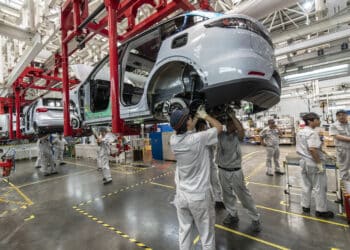Podcast: Industry reacts to tariffs, subprime market tightening
AFN looks at early tariff effects in today’s ‘Weekly Wrap’
The auto industry is rapidly responding to tariffs that took effect last week, while subprime lenders continue to navigate risk and credit performance.
Shares of the three major U.S. automakers — Ford, General Motors, and Stellantis — fell sharply at market close on April 3, dropping 5.9%, 4.3%, and 9.4%, respectively, as the tariffs officially took hold.
In response, Ford and Stellantis announced on April 4 that they will extend employee pricing to all consumers, while Stellantis and GM unveiled major production adjustments aimed at mitigating the expected rise in vehicle prices.
The looming price hikes also spurred a sales surge in March, as consumers rushed to buy ahead of anticipated increases.
As automakers react to tariffs, subprime lenders are still searching for a post-pandemic “new normal,” approaching 2025 with cautious optimism. Lenders are working to strike a balance between risk appetite and maintaining credit performance, prompting some to strategically pull back from lending to undocumented borrowers.
In this episode of “Weekly Wrap,” Auto Finance News Senior Associate Editor James Van Bramer and Associate Editor Aidan Bush unpack the initial fallout from the new tariffs and preview what’s ahead as the industry braces for long-term impacts.
Subscribe to “The Roadmap Podcast” on iTunes or Spotify or download the episode.
Auto Finance Summit East 2025 is set for May 12-14 at the JW Marriott Nashville featuring fireside chats with Santander Consumer USA and Chase Auto. Visit autofinance.live for more information. Early-bird registration is available here.
Editor’s note: This transcript has been generated by software and is being presented as is. Some transcription errors may remain.
James Van Bramer – 0:11
Hello everyone, and welcome to The Road Map from Auto Finance News — the nation’s leading newsletter on automotive lending and leasing since 1996.
Today is Monday, April 7th, and I’m James Van Bramer, joined by our newest team member, Aidan Bush. This is your weekly wrap-up of key developments in auto finance for the week ending April 4th, 2025.
The biggest headline: the official launch of auto tariffs — and the industry wasted no time responding.
For more on that, I’ll hand it over to Aidan, who has been tracking the industry’s reaction all week. Aidan?
Aidan Bush – 0:45
Yeah. So even before those April 2nd auto tariffs went into effect, we started to already see the effects of looming tariff discussions.
So, vehicle sales, for example, climbed for nearly every automaker in Q1, as some of that early discussion of these 25% auto tariffs drove customers to buy before prices increased.
On April 1st — just a day before the tariffs — major automakers like GMC and Acura held steady on incentives.
But once the tariffs went into effect last Thursday, we saw changes more in line with what economists expected. Stocks in nearly every major automaker slid throughout Thursday and Friday as the tariffs went into effect.
Automaker Stellantis announced Friday it would stop production at some of its plants in Mexico and Canada, and General Motors announced it would increase production in Fort Wayne, IN.
Maybe the most surprising reactions came from Ford and Stellantis, as they announced they would offer employee pricing to all customers in response to the tariffs — kind of flying against economists’ idea that automakers would hold on to existing supply and squeeze out profits by raising prices.
That’s it for me, James. What else should we be watching?
James Van Bramer – 1:58
A lot happened last week, so let’s dive in.
I’ll start with the broader economy. Last week, the US jobs report dropped, and we saw that US job growth actually beat expectations in March — with non-farm payrolls rising by 228,000, according to Bureau of Labor Statistics data released on Friday.
It was a broad-based gain, signaling continued labor market strength.
At the same time, Fed Chair Jerome Powell warned that the economic impact of the new tariffs may be more severe than anticipated. He emphasized the Central Bank’s responsibility to prevent any resulting inflationary pressure from spiraling.
On the auto finance fraud front — my feature on the subprime market dropped last week.
Here are a few highlights, but check out the full story on our site for a deeper dive.
Subprime lenders are cautiously optimistic right now, prioritizing stability over aggressive growth as delinquencies remain elevated, particularly in the subprime space.
Credit access has improved — but still lags behind the broader market. In response, lenders are tightening underwriting and pivoting toward higher FICO or, in some cases, near-prime borrowers.
For example, both Tricolor and Finbi — who previously had non-FICO borrowers make up over half of their portfolios — are now shifting away from that segment.
Tax refunds are also helping drive some near-term demand, but lenders agree that they don’t address the bigger issue of long-term affordability.
And finally, the new tariffs could push vehicle prices even higher — yet another potential hurdle for consumers, but a possible tailwind for lenders holding repos, which could see stronger resale values.
Obviously in the subprime space, this is kind of a specific dynamic that we are tracking.
Bottom line: Like the broader market, the subprime space is really still trying to figure out its footing in the post-pandemic lending landscape.
Well, that about wraps up today’s episode.
Thanks again for joining us on The Road Map, and be sure to follow us on—Lex, sorry—on X, LinkedIn, and visit autofinancenews.net for the latest updates.
We’ll see you next time.
Thank you.














